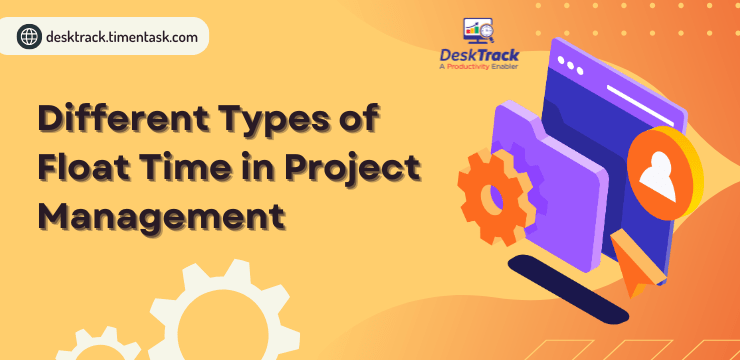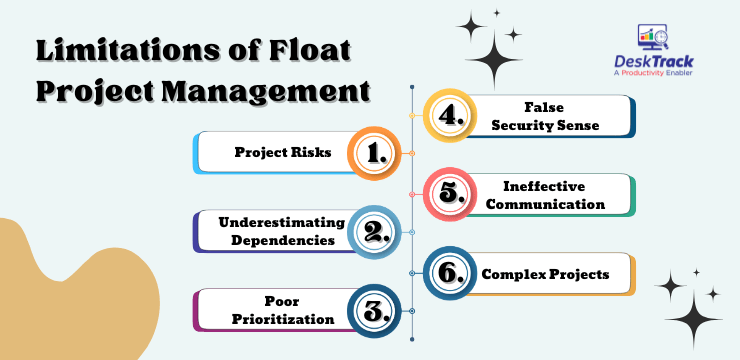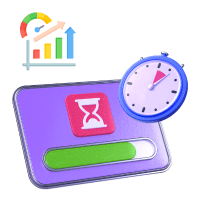
When talking about float project management, we don’t in any case mean the floating decimal point. So, what is it? Managing projects can be a painstakingly challenging task, even if everything is in order and accordingly planned. The idea here is that no team wants their projects to have obstructions and the workflow to be jittered. They all want to meet project deadlines and go home stress-free at the end of the workday.
However, even the most detailed plans can face unexpected hindrances. These issues can put you behind schedule. That’s where float in managing projects comes into play. It helps you improve efficiency, identify task prioritization, and handle delays, and setbacks. Simply put, your project is going to meet the deadline. How? We are going to explain in today’s post.
By the end of this blog, you will have a full picture of float project management, how it’s beneficial for your business, and more.
What is Float Time in Project Management?
So, what is project float? What is this element of managing projects that we are talking about? Also known as slack, it is the amount of time you can delay a project before it fails to meet the deadline. Simply put, it is a checkpoint or a marker that keeps track of the project timeline. This time in typical situations depends on:
- The tasks involved.
- The amount of slack each one allows.
Another element of float project management is the critical path. Simply put, specific tasks don’t allow flexibility and directly impact the completion date of your project. We have no choice but to complete these tasks first. To summarize:
- Such tasks that cannot begin before the completion of the previous sub-work are placed on the critical path.
- These tasks must be completed in a particular order.
- Delays in these tasks will directly affect the deadline of your project. In short, they cannot tolerate postponement.
Different Types of Float Time in Project Management

There are many categories of float in planning and managing projects. Some of these are major and others are minor floats. However, in general, you will come across these 5 commonly used types.
1. Total Float
The first category of slack in float project management is total float. In short, it is the time a scheduled task can be delayed or extended before impacting the deadline. Here’s how to calculate it:
- You must subtract the earliest from the latest.
- This can either be from the start date or the end date.
- Mixing early and late can cause serious issues.
- The formula is:
- Total float = latest start – early start/total float. Or
- Total float = latest finish – early finish.
2. Free Float
Free float is equivalent to total slack as far as calculations are concerned. However, the only difference between free float and total float is that the latter is all about project completion while the former is the amount of time you can delay a task without affecting the adjacent task on the critical path. Moreover, a thing to note here is that:
- Any delay or extension beyond the free float for managing projects of a task will directly postpone the early start date of the next task.
- Here’s the formula:
- Free slack = early start of dependent – early finish of current.
3. Project Float
The project float is straightforward. As the name suggests, this type of float project management is the total project delay or extension time before falling behind the deadline.
As far as businesses are concerned, it is the most essential value to track. However, you will need a good project management software solution to monitor it. Now, whether the client has put a time constraint or your project agreement, you cannot miss the project finish date anyway. Here are a few pointers to remember regarding it.
- It is calculated similarly to the total float.
- Total float is regarding a task or project activity. However, the project float is the entire project’s slack.
- It is essential to identify the earliest date when you can complete a project.
- Here’s the formula:
- Project float = latest project finish – earliest project finish.
4. Interfering Float
Interfering slack is the project management float regarding the time you can postpone a task without going beyond the project deadline. Simply put, going beyond this time will interfere with the project.
- When you delay a task, it does two things:
- It reduces the total float.
- Other tasks have less time flexibility.
- The interfering float will impact both critical and non-critical tasks.
- It may also take up your project float, meaning that all remaining tasks are now critical without any free float.
- It can postpone a subsequent critical task resulting in project completion delay.
- The amount of project float left due to interfering slack decides whether you can still timely complete the work.
- Here’s the formula:
- Interfering slack = total float – free float.
5. Independent Float
It is the float project management slack, which is related to both previous and current work activities. To define, it is the amount of time, you can delay the start time of an activity without impacting the next activities’ earliest start times. Here’s the formula:
- Independent float = early start of the subsequent task – late finish of the previous task – total time of prior task.
Sneak Peek: Independent float in managing projects is the postponement of any tasks that have no impact on the project’s early finish date. Come to think of it, now this slack is truly independent.
Read Also: Top 10 Best Employee Goal Management Software
How to Calculate Float in Project Management?

The previous section covered calculating the different slacks in float project management. However, what’s the common process of acquiring the float? Let’s get right into it.
1. Identify Critical Path
The first step to state project float is to derive the critical path. It’s very essential. As we mentioned before, it consists of activities that directly affect the project completion time. Remember that any postponement in the critical path activities will impact your overall project schedule.
2. Calculate ES (Early Start) and EF (Early Finish)
Now for your float project management slack, we need the early start and early finish times. These are calculated separately for each activity. Moreover, let’s see what each one means.
- ES is the earliest possible time to begin an activity.
- EF is the earliest possible time an activity can end.
3. Get LS (Late Start) and LF (Late Finish)
After we are done calculating the ES and EF, we will now calculate the late start and late finish for our schedule float. Respectively:
- LS is the latest possible time to begin the activity without postponing the project.
- LF is the latest possible time for an activity to end without impacting the project completion time.
4. Determine the Slack
Sometimes, you won’t need to calculate all types of float project management slacks. That’s why, it’s essential to decide, which float times will you calculate based on your project requirements. There are cases where some very small projects won’t require any float. So decide accordingly.
5. Calculate the Float
Now that you have the float in planning and managing projects down, we can calculate the actual float. All you have to do is:
- Use the appropriate formula.
- Put in the values.
- Calculate.
Advantages of Float Project Management for Businesses
That was all about float project management. So far we have collected many useful insights. However, what’s all the ruckus around this? Are there even any advantages of acquiring all these different slack values? Let’s get right into it.
1. Progress Monitoring Assistance
You can use schedule float to accurately track the status progress of the project. With the right slack values, you can:
- Identify tasks that are behind
- Determine tasks, which postpones will directly affect.
- Accordingly, adjust expectations and deadlines.
2. Productivity Boosts
Float project management in the planning phase is like a roadmap. You can use float or slack values or their absence to:
- Ensure the most time-sensitive activities stay on schedule.
- Avoid misses when it comes to ordering the tasks.
3. Establishes Priorities
Float in managing projects is also a good way to prioritize tasks. For example:
- You can push back tasks with time flexibility.
- This allows you to complete the short or no-float tasks first.
4. Boosts Workplace Morale
We all have our case of Monday, Tuesday, or Wednesday blues or whatever. However, using float project management, you can lift your employees’ spirits and make their work lives easier. What slack values do is:
- Give you better visibility into the critical and non-critical tasks. Here are a few examples:
- Project managers reallocating resources to delayed tasks ensuring that the project stays on time.
- Supervisors letting teams affected by postponements in advance.
5. Ensures Timely Project Completion
As we mentioned before, free project management float and all other slack values ensure that your project is always done on or before time. So that’s that. Now you know the greatest advantage of calculating float.
Limitations of Float Project Management

Like everything else, float project management also has its flaws, limitations, and disadvantages, which we need to consider before implementing it. The key to success here is to balance these benefits and limitations.
1. Project Risks
Float in planning is great and all. However, managing projects is a complex task that can have various uncertainties and unexpected risks. These issues can have a great impact on the availability and utilization of slack values.
2. Underestimating Dependencies
Another thing to consider in float project management is task dependencies. Failing to understand and account for them can lead to missed deadlines and project schedule disruptions.
3. Poor Prioritization
To appropriately schedule float, you also need to perfectly prioritize tasks. However, poor prioritization results in poor allocation of slack values.
4. False Security Sense
Another misconception about float project management is that managers feel a false sense of security. The aspect here is that you cannot completely rely on slack values.
5. Ineffective Communication
Float in managing projects can also be mismanaged if there is a lack of proper communication. This is because ineffective communication creates confusion and hinders success.
6. Complex Projects
Float project management is also not a great choice for complex projects. Here’s why.
- It assumes a predictable and linear workflow.
- Multiple critical paths are present in complex projects.
Read Also: Top 15 Benefits of Time Management Skills for Everyone
Tips for Using Float in Project Management
Using state project float has its limitations and benefits. Considering and balancing these advantages and disadvantages is the key to successful implementation. To further enhance your success chances at managing projects via slack, here are some tips and strategies.
1. Identify the Requirement
First, you need to determine whether you need the float project management approach or some other method like agile. For example, if you are handling complex projects then the former won’t work here.
2. Use the Right Software
To accrue and make efficient slack management, you need to use the correct project management float software. The software must fulfill the requirements of your execution and project teams.
3. Delegate Responsibilities
Using float in managing projects, you can delegate responsibilities to the EF date. What it does is allow your teams to end tasks early. For any postponements, you can cover the extra time before the latest project completion date.
4. Use Agile Workflows
Who said that agile workflows can only be used for agile planning and management? Using agile workflows with the slack values concept can prove very beneficial for streamlining project workflows and processes.
5. Be Prepared
Even after understanding and applying the float project management method, you still need to be prepared for any project uncertainties. These include delays, risks, last-moment client changes, and others.
Why is DeskTrack the Best for Project Management?
DeskTrack is the best employee monitoring, time tracking, and project management software integration. Using it to manage your projects will require no float or slack values as there will be no project delays. Here’s why we have been using it for years for our projects.
- Real-time activity monitoring.
- Real-time tracking.
- Seamless integrations.
- The most user-friendly interface and smartphone application.
- Real-time task, subtask, and checklist creation and tracking. Plus, there are also no limits on creating tasks and projects.
- Automated timesheets and task timers.
Conclusion
We hope that now you have wrapped your head around float project management and how it’s beneficial for handling your various tasks and projects. To give you a final word the need to determine float or slack values is to decide how far can we stretch the project deadline based on the uncertainties and risks. Float in simple terms is a checkpoint or a marker of sorts used to track the project’s timeline. However, that’s where it gets complex as there are different types of float values such as free float, independent slack, total float, inferring slack, and project float, which are related to the postponement times of work activities and projects. Float or slack provides many advantages such as productivity boosts. However, on the other hand, the biggest limitation is that even if you follow expert tips and strategies, it can’t handle complex projects, for which, we recommend DeskTrack.
Frequently Asked Questions (FAQ)
Q. What is Slack in Project Management?
Ans. The need to determine float or slack values is to decide how far can we stretch the project deadline based on the uncertainties and risks. Float in simple terms is a checkpoint or a marker of sorts used to track the project’s timeline.
Q. What are LS, ES, LF, and EF Values in Float?
Ans. LS, ES, LF, and EF are the latest start, earliest start, latest finish, and earliest finish dates and times respectively.
- ES is the earliest possible time to begin an activity.
- EF is the earliest possible time an activity can be finished.
- LS is the latest possible time to begin the activity without postponing the project.
- LF is the latest possible time for an activity to end without impacting the project completion time.
Q. What are the Different Types of Float?
Ans. There are various categories of float values you need to calculate. Commonly you will find these 5 in use.
- Inferring Float
- Independent Float
- Total Float
- Free Float
- Project Float











